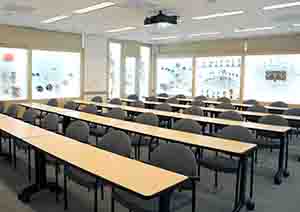The Alfred Q. Shryock Museum of Embryology is housed in the Centennial Complex and was founded by Alfred Shryock who served as chair of the division of microscopic anatomy for about 40 years beginning around 1912.

Very early in his tenure, Dr. Shryock recognized the value of a high quality collection of human fetuses and models that accurately portrayed the developmental processes. He developed a network of physicians around the country who sent him well preserved aborted fetuses (from cases in which the mother's life was threatened by the pregnancy) as well as abnormally developed and nonviable fetuses. These specimens were prepared to demonstrate the progress of development especially during the first trimester. One such series was stained with alizarin red and cleared to show sites of calcium deposition in the skeleton. This was loaned to be part of the exhibits at the California Pacific Exposition in San Diego 1935-1936.
He acquired a set of exquisitely prepared wax models by Friedrich Ziegler (1860-1936) of different stages of development of the human embryo as well as specific organs. These portray the earliest stages of the development of the cardiovascular and nervous systems.
Today, in addition to serving as a teaching resource for students of the health professions, many classes from high schools and colleges tour this facility. The Museum maintains a library of educational films designed to help lay people understand the processes of pregnancy and birth. Risk-related behaviors are also known to increase the risk for malformations. These resources are seen as especially valuable in teaching respect for and the care of the unborn child.
Visiting the museum
To schedule an educational guided tour for your class, please call the Anatomy Office at (909) 558-7602.
[Top]
